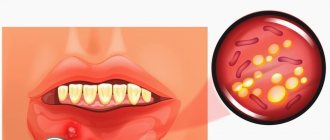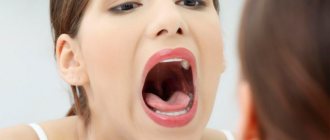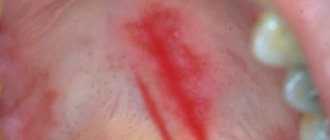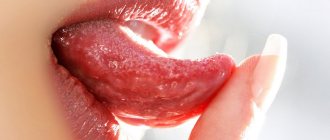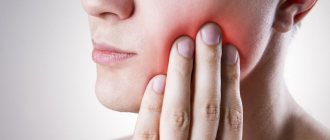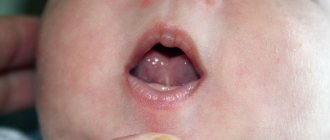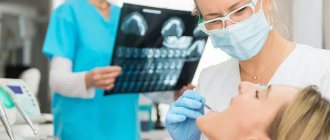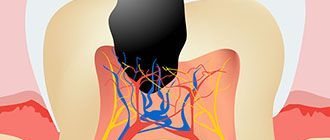When performing daily hygiene procedures for cleaning the oral cavity, you should carefully examine the mucous membrane of the palate and tongue.
Identified red spots, plaque and yellowness indicate problems that have arisen in the body. It is easier to prevent the development of any disease if you seek help from a doctor as early as possible.
Causes
The palate area, like other areas of the skin and mucous membranes, is characterized by a strong blood supply, which is due to the presence of a dense network of capillaries.
The normal color formed on the surface indicates the absence of an inflammatory process in the body and other serious disorders. A change in the color of the palate is a manifestation of the symptoms of the disease, which is determined after the study.
The reasons that provoke the formation of yellowness can be found in the table:
| Reasons for the formation of yellow plaque on the palate | ||
| Reason name | Description | Additional symptoms |
| Liver diseases | The most common liver diseases, recognized by the yellowness of the palate, are: jaundice, cirrhosis, cholecystitis, cholelithiasis and syphilis. When an organ is damaged, disruptions in the functioning of all systems and metabolic processes occur: protein, carbohydrate, fat, pigment, etc. Depending on the disease, the corners of the palate and the boundaries between soft and hard tissue (with cholecystitis, bile stones) or the entire surface of the mucous membrane turn yellow. (for hepatitis). |
|
| Pancreas problems | The organ regulates energy exchange and biochemical processes occurring in the human body. If there are problems with the pancreas, one of the main signs is that the soft palate acquires a bronze tone. If malfunctions occur in the biliary system, the color is combined with pronounced jaundice. |
|
| Intestinal inflammation (large/small) | Yellowness on the upper palate with intestinal dysfunction appears due to the morphofunctional unity of the oral mucosa and the gastrointestinal tract. The color of the palate changes to yellowish both in individual zones and over its entire surface. The neglect of the disease is reflected in the intensity and structure of plaque. |
|
| Kidney failure | The main provocateurs of renal failure: urolithiasis, diabetes mellitus, pyelonephritis, neoplasms, lipid metabolism disorders. As a result of a failure of metabolic and biochemical processes, yellowness appears on the hard palate. Additional symptoms help determine whether the kidneys are involved in the problem. |
|
| Cholesterol and fat metabolism disorders | Cholesterol metabolism disorders are accompanied by a change in the color of the soft palate from pink to yellow. At the same time, gray lumpy spots are clearly visible on the surface of the mucosa. Failures in fat metabolism are recognized by a pale icteric coating on the palate. The main provocateurs of metabolic disorders are: tuberculosis, diabetes, oncology. |
|
| Smoking | The color of the palate changes under the influence of resins, which are included in tobacco in high concentrations. A bad habit provokes disruption of blood circulation and biochemical processes in tissues associated with disruption of metabolic and other processes. The mucous membrane loses its pink color and becomes yellow. |
|
Diagram of the oral cavity
You've probably wondered before: why is the sky blue? And they heard the wrong answers: because it reflects the ocean; because oxygen is a blue gas; because sunlight has a blue tint. In truth, the sky looks blue for three simple reasons.
First, sunlight is made up of different wavelengths. Secondly, the Earth's atmosphere is made up of particles that scatter light of different wavelengths differently. Third, our eyes react to different colors in interesting ways.
What is sunlight made of?
The entire range of the light spectrum consists of visible rays, infrared rays and ultraviolet rays. The energy of visible light is approximately 50% of the energy of solar radiation. Visible light is the only region of the electromagnetic spectrum that can be seen with the naked eye, while ultraviolet and infrared rays are not visible to the human eye.
Visible sunlight consists of the colors red, orange, yellow, green, blue and violet.
Violet light (like blue) has the shortest wavelength and therefore the highest vibrational frequency in the visible spectrum. Since frequency is directly proportional to energy, violet light also has the most energy. On the other hand, red light has the longest wavelength, lowest vibrational frequency, and lowest energy.
How does light travel on Earth?
Sunlight is scattered in all directions by all the gases and particles present in the Earth's atmosphere.
The tiny invisible particles that make up our atmosphere - molecules of nitrogen, oxygen, water, carbon dioxide, and argon atoms - scatter light of all wavelengths. However, they scatter light at shorter wavelengths much more efficiently.
What is Rayleigh scattering that turns the sky blue?
The blue color of the sky is explained by a phenomenon called Rayleigh scattering. It is the scattering of light or other electromagnetic radiation by particles much smaller than the wavelength of the radiation.
Solar radiation that reaches the Earth's surface after scattering in the atmosphere is called scattered celestial radiation. The shortest wavelengths of light are easily scattered, particularly blue light waves, which is why we see the sky blue.
Why isn't the sky purple?
If violet has the shortest wavelength and is easily scattered, why is the sky blue and not violet?
The reason is the sensitivity of our eyes to light. Although violet is the dominant color in the atmosphere around us, the retina of the human eye is not sensitive enough to this color, unlike blue.
Forskning.no 03/07/2021 Al Jazeera 03/20/2021 Forskning.no 04/04/2021
More violet light comes from the atmosphere than blue light, but our eyes respond more strongly to blue, cyan and green wavelengths of light than to violet light. So, although there is a lot of violet light, it is not enough to overcome the strong blue signal that our brain transmits.
But if we can see ultraviolet rays, the sky will likely become more purple.
If the sky were violet, our eyes would see it as purple, but because violet and blue light overlap, we see the sky as pale blue.
And if human eyes were like the eyes of dogs, we would see the blue sky during the day, but we would not be able to see the red, orange and yellow colors at sunset.
What is the secret of orange twilight?
At sunset and sunrise, the angle of penetration of sunlight into the atmosphere changes dramatically. Most blue and green light waves are scattered before they reach the lower atmosphere, so we see more orange and red hues in the sky.
Does the ocean reflect the color of the sky?
Many people think that the ocean is blue because it reflects the sky, but this is not true. In fact, water appears blue because its molecules absorb red light.
As light penetrates deep into the water, waves of different wavelengths are successively filtered out. Water molecules absorb red light but reflect blue light.
For this reason, shallow bodies of water tend to appear less blue than deep ones.
For example, in a cup of water there are not enough molecules to absorb photons, so the light penetrates through it, and we see that the water is colorless.
Why does the Earth appear blue from space?
When we look at the Earth from space, it looks like a blue ball due to the predominance of seas and oceans (70.8%) over land (29.2%).
The number of bodies of water is one of the reasons why Earth is the brightest planet in the solar system. The bodies of water on its surface reflect sunlight, making the planet look like a bright blue pearl.
Is the sun yellow or orange?
Young children usually draw the sun as yellow, orange or even red. The cultural factor also plays a certain role in this. For example, American children tend to draw the sun in yellow, while Japanese children tend to draw it in red. But in reality the sun is white.
The sun is all the colors mixed together. To our eyes they appear white. This is easily confirmed by photographs of the Sun taken in space.
Do the skies also appear blue on other planets?
The color of the sky on a planet depends on the composition of its atmosphere. For example, the atmosphere on rocky Earth-like planets contains a certain amount of gases, the combination of which gives the planet's atmosphere its corresponding color.
Mars' gas envelope is composed primarily of carbon dioxide and small dust particles, which scatter light differently than gases and particles in Earth's atmosphere.
Videnskab 21.10.2020
NASA photographs have shown that what happens on Mars is exactly the opposite of what happens on Earth. The sky on Mars takes on an orange or reddish hue during the day and turns grey-blue at sunset.
The atmospheres of the two ice giants Neptune and Uranus have incredible shades of blue due to their high methane content.
Uranus' atmosphere contains some ammonia, which makes the planet slightly greener, in contrast to Neptune's dark blue.
Saturn, on the other hand, has a pale yellow hue due to ammonia crystals present in the upper layers of its atmosphere.
In the atmosphere of Jupiter there are characteristic brown and orange stripes - this is due to gases, which include phosphorus and sulfur, and perhaps more complex chemical substances - hydrocarbons.
InoSMI materials contain assessments exclusively of foreign media and do not reflect the position of the InoSMI editorial staff.
Yellow palate in the mouth of an adult
In people over 50 years of age, the appearance of a yellow coating on the palate is considered a physiological process
If the sky has turned yellow, you should see a dentist. During the examination, the specialist will determine whether the yellowness of the mucous membrane is a sign of any disease, or indicates a lack of proper oral hygiene.
The patient’s attitude towards bad habits is also taken into account. Yellowness with a pronounced network of veins is often formed as a result of regular smoking.
When conducting diagnostics, the patient's age is taken into account. In people over 50 years of age, the appearance of yellow plaque on the palate is considered a physiological process, so serious health problems are not always detected.
The child has
A yellowed sky appears not only in adults, but also in children. In addition to dental problems, this sign may indicate other diseases, so the child should be shown to a gastroenterologist, ENT specialist, pediatrician, infectious disease specialist, or hepatologist.
Often, young patients with this symptom are diagnosed with thrush. If there is any doubt in determining the problem, it is recommended to undergo a full examination, including donating blood to check bilirubin levels.
Empty sky. Who will suffer more from the ban on flights over Belarus?
The European Union called on air carriers to refuse flights to Belarus. The corresponding statement was made following the first day of the summit of leaders of EU member states in Brussels. The world's airlines have heard the call and one after another are refusing to fly over Belarus. Participants in the boycott included, for example, Latvian AirBaltic, German Lufthansa, Dutch KLM, Swedish SAS, Polish LOT, Hungarian Wizzair and Cypriot Avia Solutions.
The national Belarusian airline is also forced to cancel flights to Europe due to the ban on flights through “foreign skies.” For example, there will be no flights from Minsk to Paris and London from May 25 to October 30. “We are upset by the current situation, which we cannot change. We apologize to passengers,” the airline said. EU countries announced that they have agreed to ban Belavia from using European airspace and landing at European airports, which not only effectively means for the Belarusian carrier the cessation of flights to the EU, but will also make it difficult to fly to, for example, Turkey or Egypt.
US President Joe Biden wants to bring to justice those involved in the emergency landing of an Irish Ryanair plane flying from Athens to Vilnius. The official statement of the American leader was published on the White House website. Biden intends to conduct an international investigation and supports the EU's idea of sanctions against Minsk. And National Security Adviser to the American President Jack Sullivan discussed what happened with former Belarusian presidential candidate Svetlana Tikhanovskaya . As a result of this conversation, he demanded the release of journalist Roman Protasevich, detained on suspicion of extremism .
They planted and planted. Ex-editor of Nexta was arrested in Minsk Read more
Meanwhile, the EU may impose sanctions against the export of oil products, fertilizers, tractors from Belarus, as well as the country’s access to technology, the Lithuanian Foreign Ministry reports. At the same time, Brussels is hinting that Minsk had the opportunity to receive 3 billion euros in investment assistance if it followed the path of “democratization of the republic.” This statement was made by the head of the European Commission, Ursula von der Leyen, on the sidelines of the summit. After Protasevich’s arrest, money will definitely not be given to Minsk. By the way, in November last year, the EU already promised to allocate funds to Belarus to support activists, including participants in protests. At that time, the amount discussed was 24 million euros, reports the Rossiya-24 TV channel.
But, perhaps, the loudest statement in the wake of the scandal with the landing of the plane and the arrest of Protasevich was made by the deputy of the Latvian Seimas, Aigars Bikše. He proposed no less than to take hostage the hockey players of the Belarusian national team who are in Riga in order to demand that Minsk release all political prisoners in exchange for them.
AiF.ru discussed the development of the situation around Belarus with Associate Professor of the Department of Political Theory at MGIMO, international political scientist Kirill Koktysh .
Evgeny Maslov, AiF. ru : Kirill Evgenievich, what does the empty sky threaten Minsk with?
Kirill Koktysh: This sky is still empty, rather at the level of emotions and political declarations. It will not be so easy to implement such a threat. First of all, aviation flights take place on the basis of bilateral interstate agreements. It is necessary to either suspend or denounce these agreements altogether. A political declaration is, of course, a good thing, but I think that at the stage of technical implementation there will be a huge number of nuances that will correct all this.
— So the supporters of tough measures won’t have enough passion for a long time?
- Of course, it won’t be enough. Because of the ban, it will be difficult for Belavia. Here Russia can take a step that Belarusians have been waiting for a long time: reduce tariffs so that it does not pay for flights through Russian airspace as a foreign carrier, that is, 10 times more than domestic carriers. If economic conditions are leveled, this will be quite powerful support.
Plus, let’s not forget that European passengers will be the first to suffer from the ban on flights to Minsk and over Belarus: failure to use the Belarusian hub and Belarusian skies means an inevitable increase in flight prices and extra travel time.
They didn't sit there. How an emergency with an airplane could turn out for Minsk Read more
— It turns out that there are a lot of difficulties, but politics has prevailed over pragmatics?
— Discomfort, as a rule, is bilateral. We must understand that today’s outburst of emotions is designed to drown out and delegitimize those things that Minsk will begin to say after Protasevich began to testify. Here we see banal pragmatics: the desire to make sure that these testimonies are perceived as unreliable.
Because, if you look without emotion, the Belarusian authorities did not do anything supernatural and remained within the framework of international law: a sovereign state has the right to inspect any vehicle that moves across its land, waters and air. And let's not forget that there have already been such precedents. This included the search of Evo Morales’ , the forced landing of a Belavia plane by Kiev, the landing of an Iranian airliner by the Americans, etc. There were quite a lot of interventions of this kind that were not carried out by superpowers, and this did not cause such a big international response. Therefore, it is obvious here that the cause of the scandal is not the landing of the plane itself, but what data Minsk can get at its disposal as a result of this.
Protasevich, I’m sure, has something to tell. He knows a lot about organizing and financing protests. In this regard, the Belarusian authorities received a very valuable source of information, which is why the West launched such a campaign to deliberately discredit all his testimony.
— There is a version that now they will try to drag Moscow into this story: supposedly the Belarusians worked with our special services to disrupt the meeting between Putin and Biden.
— Europe is just a choir that doesn’t decide anything in the solo parts of Moscow and Washington. When they say that the Kremlin is to blame, it’s just a good way to warm up passions so that later they can agree on something.
Diagnostics
Based on the visual examination, the doctor plans further diagnostics.
The initial examination should be entrusted to the dentist; problems with the oral cavity are within his competence. The specialist studies not only the oral mucosa, but also the condition of the gums, teeth and the gaps between them.
This is where signs of thrush or stomatitis may appear. Based on the visual examination, the doctor outlines the following stages of diagnosis.
Changed color of the palate may be an independent condition or indicate the development of other diseases.
To clarify the diagnosis, the dentist refers the patient to the following specialists:
- otolaryngologist;
- therapist;
- oncologist;
- allergist.
Diagnostics also includes laboratory tests of biological samples: blood, urine, feces.
If an allergy is suspected, the patient is referred to undergo:
- Ultrasound;
- CT;
- MRI;
- x-ray.
The doctor examines the oral cavity
Treatment
Signs of pharyngitis
The results of the patient's studies indicate a problem existing in the body.
A specialist with a narrow profile will be able to prescribe treatment: nephrologist, gastroenterologist, urologist.
If signs of a systemic disease are detected (syphilis, rheumatism, HIV, etc.), a referral is given to the hospital of a specialized medical institution.
When oncology is detected, a treatment regimen is developed jointly with other specialists: a surgeon, oncologist, neurologist, ophthalmologist, etc.
Diagnosing a local viral infection on the oral mucosa involves prescribing antiseptics and antibiotics to suppress the inflammatory process and destroy the pathogen. The same drugs are used to treat periodontitis, gingivitis and in cases where it is necessary to prevent ulcerative-necrotic complications.
Whatever treatment method is chosen, the doctor also prescribes oral hygiene procedures:
- professional cleaning;
- selection of products for daily hygiene of the dentition and oral mucosa;
- regular rinsing with an antiseptic solution.
An equally important step is strengthening the body’s protective functions. For these purposes, regular intake of vitamin complexes is suitable, which promptly replenish the deficiency of essential vitamins and minerals.
Liver pathologies
When it comes to changing the appearance of the mucous membranes, first of all, suspicion falls on a disruption in the functioning of this particular vital organ. The liver performs many functions, including the regulation of fat and carbohydrate metabolism and the digestion process. It removes harmful substances from the body and takes a hit when affected by various viruses.
Common liver problems that affect the color of the sky include:
Jaundice
Jaundice, in which the concentration of the hormone bilirubin in the blood of an adult or child is exceeded. The mucous membranes become yellow. This phenomenon is considered a sign of damage by hepatitis viruses, liver cirrhosis, and obstruction of the biliary tract. The patient also complains of nausea, vomiting, belching and problems with bowel movements.
Treatment is prescribed after diagnostic measures have been carried out and the virus that has caused the change in pigmentation has been identified.
Syphilis
Syphilis is in the second stage, lasting from 2 to 5 years, which is characterized by a wave-like course, when symptoms appear and disappear from time to time. The main signs of this pathology with liver damage are the appearance of yellow spots in the mouth. The patient feels weakness and aching muscles, like during a cold. Hair begins to actively fall out.
A patient with syphilis can avoid unpleasant symptoms and further damage to all vital organs if treatment is started in a timely manner. The venereologist selects therapy for the patient depending on individual characteristics.
Most often, penicillin or antibiotics with a different composition are used if there is intolerance to the first component. Additionally, measures are taken to strengthen the immune system.
The degree of recovery is determined by laboratory tests. The patient and those in close contact with him are treated until blood tests show the complete absence of spirochema pallidum in the body.
Cholelithiasis
Cholelithiasis or cholelithiasis, leading to a yellow tint to the palate. Its cause is considered to be the filling of the gallbladder with stones formed as a result of the accumulation of cholesterol, salts and other elements. Cholelithiasis is accompanied by disruption of the normal circulation of bile and its stagnation.
To eliminate this problem, various methods of breaking stones are used. In advanced cases, it is necessary to remove the gallbladder through surgery.
Cholecystitis
Cholecystitis or chronic inflammation of the gallbladder, accompanied by pronounced yellowness at the junction of the hard palate and the soft palate. Additional symptoms include a bitter taste in the mouth, nausea, vomiting and pain in the right hypochondrium. The gastroenterologist prescribes therapy to the patient who has been diagnosed with antibiotics, drugs to normalize digestion and detoxification.
Problems with the liver and gall bladder are quite serious pathologies that require mandatory monitoring by an appropriate specialist. The longer the patient ignores the alarming symptoms and treats himself, the more difficult it is to get rid of the consequences of the disease.
Traditional methods
To remove yellow plaque from the palate, local treatment with various infusions and their internal use are recommended.
In folk medicine, mainly components of plant origin are used, which have anti-inflammatory, antiseptic and other effects.
To remove yellow plaque from the palate, local treatment with various infusions and internal use of infusions and products to strengthen the body's protective functions are recommended.
Eg:
- infusions and teas from marshmallow root, St. John's wort, licorice, and chamomile provide an excellent antiseptic effect;
- rinsing the mouth with a decoction of sage, calendula, and yarrow has an antibacterial effect;
- consuming bee products and citrus fruits strengthens the immune system.
The traditional medicine methods used must complement the general principles of treatment recommended by the doctor, but in no case should they contradict official requirements.
It is also worth considering that infusions, decoctions and teas have an enhancing effect of traditional therapy, but they cannot replace drugs and procedures.
Preventive measures
As a preventive measure, after eating you need to rinse your mouth with a special balm or at least clean water.
As a preventative measure, it is recommended to periodically undergo dental examinations.
This will help identify the disease at an early stage and begin a course of treatment in a timely manner, thereby preventing the development of complications.
It is also necessary to carry out daily oral hygiene procedures to remove food debris and remove plaque from the mucous membrane.
The main defense of any person is, first of all, immunity. To strengthen it, you should maintain physical fitness, radically review your diet, and enrich the body with valuable minerals and vitamins.
The following recommendations are also preventive measures:
- You should not overuse spicy, salty foods, or foods with a hard structure;
- after eating, you need to rinse your mouth with a special balm or at least clean water;
- If you experience unpleasant sensations in your mouth, rinse for several days using decoctions of propolis, chamomile, oak bark or sage.
Quitting bad habits, in particular smoking, can prevent the formation of yellow plaque on the palate.
Gastrointestinal tract dysfunction
The shade of the oral mucosa and hard palate changes to yellowish as a result of certain pathologies of the digestive system.
- Gastric ulcer , in which lesions form on the walls of the stomach. The patient feels restlessness in the left hypochondrium most often after eating. Additional signs of this pathology include nausea, vomiting, increased gas formation, coating on the tongue and a yellow palate. The patient is prescribed a special diet, physiotherapy, recommended to avoid stressful situations, and prescribed medication. Sometimes surgery is required.
- Gastritis in chronic form is an inflammation of the gastric mucosa with the appearance of belching, heartburn, unpleasant taste in the mouth, and rumbling in the stomach. A yellowish coating on the palate and tongue is also possible. Therapeutic measures include changing eating behavior, giving up addictions - alcohol, smoking, and taking medications.
- Colitis or inflammation of the large intestine , in addition to the characteristic plaque on the hard palate and tongue, is accompanied by abdominal pain, constipation or diarrhea, an admixture of mucus, blood or purulent discharge in the stool. Treatment of colitis is carried out in hospitalization. Foods that irritate the intestines are removed from the diet. If necessary, treat with antibiotics and anthelmintics.
If symptoms characteristic of one of the above gastrointestinal diseases appear, you should immediately seek help from a gastroenterologist.
- Lump on the upper palate - what to do;
- Viscous, thick, viscous saliva in the throat - the causes of its appearance;
- Something bothers me in my throat -
